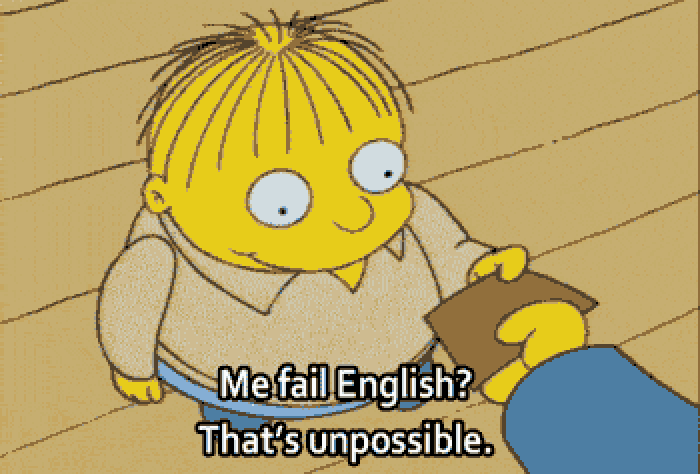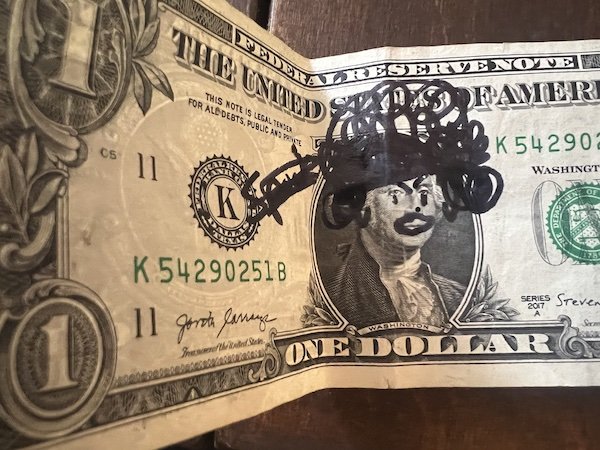Bill to Unpossible Location featuring The Incorrect Prediction Marking Technique
/Imagine
Last weekend, I was staying with my friend Tim in Maryland.
On Saturday, when we went out for lunch, I said…
“Do you have a dollar? I’ll show you something.”
He takes a dollar from his wallet and gives it to me, and I say, "Hold on," and I proceed to draw something on the front of the bill, shielding it from his vision. Then I turn the bill over and place it in the middle of the table between us.
"I've made a prediction. I have a list of famous people on my phone. You're going to choose one at random, and it will be the person I predict. If I'm right, I get to keep your dollar. If I'm wrong, you keep your dollar and... you get a prize."
"What's the prize?" he asks.
"Oh boy, it's something...," I look around as if scanning for what his prize might be. "It's something really great. I don't want to get you too hyped about it because you're not going to win. Go ahead, name a number between 1 and 100."
He names 16.
I furrow my brow a little. "I think that's right," I say. I turn on my phone and have him open the notes list and go to my list of famous people. "Who's at that number?"
"Ronald McDonald," he says.
"Are you sure that's 16?" I ask, turning my head to get a better look at the list. “It’s not Spock from Star Trek?”
He points out the number to me, so I can see it clearly.
“Oh… okay. Yeah. Let me clarify my prediction,” I say.
I turn the bill over. It’s clearly Spock. It’s labelled Spock.
“Just need to add a couple more details here so it’s really clear.”
I scribble out “Spock,” and add some clown details to the pictures.
“Bam!” I say, turning the bill towards him. “Ronald McDonald.”
“No, okay. I fucked up. It worked yesterday, and I really thought I had that down. I will think of a good prize for you.”
A couple of minutes later, I say, “Oh, I know. I’ve got your prize. I’m going to show you something amazing.”
I take the bill and ball it up and hold it in my fist [false transfer]. A moment later, I open my hand and it’s gone.
“I’ve sent the bill back in time. It is now in your wallet again, unmarked, and completely unwrinkled.”
Considering that would make the bill completely indistinguishable from any other bill in his wallet, this doesn’t seem like much of a trick
I acknowledge the look he gives me because of this fact and say, “Oh, right, that wouldn’t be much of a trick. Okay… it’s just back in your wallet.”
Unconvinced, he pulls his wallet out of his pocket and opens it. In amongst his bills is the uncrumpled (but still very wrinkled) and marked up bill. “Okay… that one actually is really messing with my mind,” he says. Which is just about as good as a reaction as I’ve ever been able to squeeze out of this guy.”
Method
This is not a method for bill to wallet, necessarily. It’s a method for bill to impossible location. I was able to do bill to wallet because I was staying with my friend and had access to his wallet the night before, and he happened to have enough bills in there that I could pre-load a dupe in the middle of them without it being noticeable.
I included this technique in another trick I’ve posted here in the past, but I think the concept deserved a little more attention than I originally gave it.
It’s an interesting concept because we’re using magic to get something wrong.
Let’s start with a bad Bill to Impossible Location effect.
You give me a bill, I make it vanish. It reappears taped under your seat.
You say, “It’s a different bill.”
A little better
You give me a bill, I sign it, I make it vanish. It reappears taped under your seat.
Maybe a brief moment of surprise, but you soon think: “Surely, that’s a different bill he signed.” If the purpose of “signing” it was to make it unique, then I would have had you do it, you realize.
A little better
You give me a bill. I write the date and time on it to mark when this event happens. I make it vanish. It reappears taped under your seat.
This is getting stronger. Now I’m not signing it “to make it unique.” I’m writing on it for another purpose, and the byproduct of that purpose is that it’s now a more distinct bill. But still, after a moment you’ll likely consider I may have timed it out and this is just a duplicate bill.
A little better
You give me a bill. I write the date and time on it to mark when this event happens. Oops, you inform me I got the date wrong. Let me cross that out and correct it. Now I make it vanish. It reappears taped under your seat.
You can see how this is getting more and more convincing of it being the same dollar. But despite that, a spectator can still work out that I’m the one who controlled everything that was written on the dollar. And while a duplicate bill with the same markings might not be the solution they come to as immediately, it’s still the one they’re likely to come to.
Another method people use as a way to distinguish a bill other than a signature is to write a prediction down on it. I feel like maybe this is something I’ve seen from David Acer or Richard Sanders or someone else equally Canadian. [Update: It was Richard Sanders. Bill Anywhere from The Richard Sanders Show, Vol 2 (great DVD set, btw).]
So, for example, first I predict the card you’re going to pick on this bill. Later I make the bill disappear, and it reappears with that same written prediction on it, suggesting it’s the same bill.
While this adds another piece to the puzzle, if you could accurately know what card they would pick in advance, then it’s not so difficult to imagine you could write that down on a different bill.
When you predict their card, the question in their mind is, “How could he know what card I’d pick?” If they suspect a duplicate bill, then it’s still the same question in their head, “But how could he know what card I’d pick?” The impossibility of the situation hasn’t really strengthened. It’s still just predicated on you somehow knowing the card.
The Incorrect Prediction Marking Technique
Here, we’re going to force the outcome (in the example above, using the Digital Force Bag App) but we’re going to get the prediction wrong.
We then correct the prediction in a humorous way.
This leaves us with a seemingly uniquely marked object, that you (the magician) could not have anticipated.
What makes this so psychologically disarming is that it just doesn’t occur to people that a magician would use trickery to be wrong. This is so far from their conception of how magicians work and what motivates them. Here we’re actually using the negative stereotype of magicians—that we use trickery to make ourselves look smarter or better than other people—as a way to fool people.
You might say, “Just use a torn corner on the bill if you need a dupe that can’t be signed by the spectator.”
I would say: Use Both. The torn corner will make the Incorrect Prediction Marking Technique stronger. And the IPMT has a benefit the torn-corner doesn’t. (See if you can figure out what that benefit is before the end of this post.)
To be clear, this is not a Dollar Bill/Digital Force Bag/Bill to Impossible Location trick.
This is an Any Object/Any Force/Any Effect where you need a duplicate object technique.
For example, you show someone your book of baseball players autographs. You make a prediction on a baseball of the person whose autograph they’ll choose. They pick Mickey Mantle (via a Svengali pad autograph book). You wrote down Derek Jeter.
Refusing to admit defeat, you jank it up so it looks like Mickey Mantle. “See, I got it right!” you say.
In mock defeat, you throw the baseball into the lake.
“I’ll show you a better trick,” you say. And you mime grabbing some energy from the lake and projecting it to your lake cabin.
You go inside, and on a bookshelf, in a glass display case, is the baseball wrapped in seaweed.
The beauty of this technique? The added benefit of the IPMT that I mentioned above? Here’s what it is. This technique very strongly suggests a unique object. BUT… if it all falls apart—if they say, “No way… that’s a different baseball (or bill or whatever)”—then what you have is… a strong prediction trick that plays out in an entertaining way. There’s no downside.

















